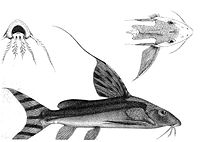
Synodontis nigrita, known as the false upside down catfish, is a species of upside-down catfish that occurs widely in northern Africa. It was first described by French zoologist Achille Valenciennes in 1840. The type specimen is in the Muséum National d' Histoire Naturelle de Paris.
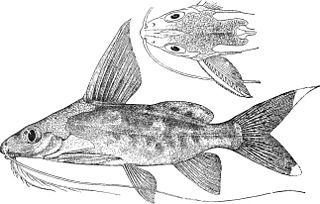
Synodontis alberti, the bigeye squeaker, Albert's syno, bigspotted squeaker, or high-fin synodontis, is a species of upside-down catfish native to the Congo Basin of Cameroon, the Democratic Republic of the Congo and the Republic of the Congo. It was originally described in 1891 by Belgian ichthyologist Louise Schilthuis after its discovery in the Malebo Pool of the Congo River.
Synodontis aterrimus, known as the network synodontis, is a species of upside-down catfish that is endemic to the Democratic Republic of the Congo where it is found in the middle Congo Basin. It was first described by Max Poll and Tyson R. Roberts in 1968. The original specimens were obtained in Bokuma, on the Congo River in what is now the Democratic Republic of the Congo. The species name aterrimus means "very black", referring to the dark coloration on the underside of the body.
Synodontis camelopardalis, known as the giraffe synodontis, is a species of upside-down catfish that is endemic to the Democratic Republic of the Congo where it is only known to occur in the Tshuapa River. It was first described by Max Poll in 1971. The original specimens were obtained in Eala, on the Ruki River in the central Congo River Basin. The species name camelopardalis refers to the giraffe, Giraffa camelopardalis, in reference to the coloration of the fish.
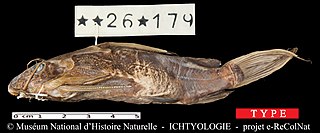
Synodontis centralis is a species of upside-down catfish that is endemic to the Democratic Republic of the Congo where it occurs in the middle Congo Basin. It was first described by Max Poll in 1971. The original specimens were obtained in Ndwa village, Kunungu, Zaire. The species name centralis refers to its habitat in the central Congo Basin.

Synodontis clarias, known as the red tailed synodontis, or the mandi, is a species of upside-down catfish that occurs widely in the waters of northern Africa. It was first described by Swedish zoologist Carl Linnaeus in 1758 as Silurus clarias. The original specimens were obtained in Egypt, near Cairo. The meaning of the species name clarias is not certain, but may possibly have been used to mean "bright" or "clear".

Synodontis depauwi is a species of upside-down catfish that is endemic to the Democratic Republic of the Congo where it can be found in Stanley Pool. It was first described by British-Belgian zoologist George Albert Boulenger in 1899, from specimens collected in Stanley Pool, in the Democratic Republic of the Congo. The species name depauwi is in honour of the "conservateur des collections de l'Université libre de Bruxelles", Louis De Pauw.
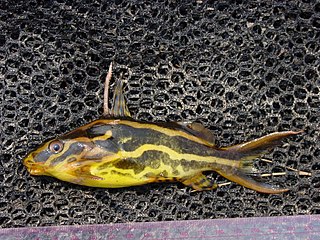
Synodontis flavitaeniatus, known as the orangestriped squeaker, the chocolatestriped squeaker, the yellowstriped squeaker, and the pyjama Syno, is a species of upside-down catfish native to the Democratic Republic of the Congo and the Republic of the Congo where it is found in the lower and central Congo Basin. It was first described by Belgian-British zoologist George Albert Boulenger in 1919. The holotype was collected from the Ruki River at Eala, in the Democratic Republic of the Congo. The meaning of the specific name "flavitaeniatus" is "yellow stripes".

Synodontis frontosus, known as the Sudan squeaker, is a species of upside-down catfish that is widely distributed throughout northern and central Africa. It has been reported in Chad, Democratic Republic of the Congo, Ethiopia, Kenya, Somalia, Sudan, and Uganda. It was first described by French zoologist Léon Vaillant in 1895, from specimens collected in the White Nile in Sudan. The species name frontosus is Latin, and means "broad head".

Synodontis longirostris, known as the eyespot synodontis, is a species of upside-down catfish that is native to the Democratic Republic of the Congo where it occurs in the Congo Basin. It was first described by British-Belgian zoologist George Albert Boulenger in 1902, from specimens obtained in the Ubangi River at Banzyville. The species name longirostris comes from the Latin word longus, meaning "long", and the Latin word rostrum, meaning snout, referring to the long snout on this species.
Synodontis marmoratus is a species of upside-down catfish that is native to Cameroon where it is found in the Sanage and Nyong Rivers. It was first described by Swedish zoologist and conservationist Einar Lönnberg in 1895, from a specimen collected from Bonge, Cameroon.

Synodontis multimaculatus, known as the dotted synodontis, is a species of upside-down catfish that is native to the Democratic Republic of the Congo where it is found in the Ubangi River. It was first described by British-Belgian zoologist George Albert Boulenger in 1902, from a specimen collected in the Ubangi River in Mobayi-Mbongo, the Democratic Republic of the Congo. The species name multimaculatus is derived from the word multi, meaning many, and the Latin word maculatus, meaning spots, referring to the many spots on the fish.

Synodontis nigromaculatus, known as the spotted squeaker, the blackspotted squeaker, or the speckled squeaker, is a species of upside-down catfish that is found widely in southern Africa. It has been identified in Angola, Botswana, the Democratic Republic of the Congo, Mozambique, Namibia, South Africa, Zambia, and Zimbabwe. It was first described by British-Belgian zoologist George Albert Boulenger in 1905, from specimens collected in Lake Bangweulu in Zambia.
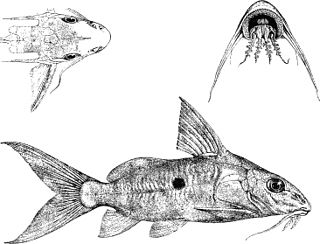
Synodontis nummifer, known as the two spot synodontis, is a species of upside-down catfish native to the Congo Basin of Cameroon, the Democratic Republic of the Congo and the Republic of the Congo. It was first described by the Belgian-British zoologist George Albert Boulenger in 1899, based upon a holotype discovered in Léopoldville, Belgian Congo. The specific name "nummifer" comes from the Latin for "to bear a coin", which refers to the large spots on its sides.

Synodontis ocellifer, known as the ocellated synodontis, is a species of upside-down catfish native to the rivers of northern and western Africa. It has been reported in 10 countries, including Burkina Faso, Cameroon, Chad, Gambia, Ghana, Guinea, Mali, Niger, Nigeria, and Senegal. It was first described by Belgian-British zoologist George Albert Boulenger in 1900, from specimens collected in Kunchow Creek, in Gambia. The species name ocellifer comes from the Latin word ocellus, meaning "eye", and the Latin word ifer, meaning "to carry", which refers to the black spots, possibly with white centers found on the sides.
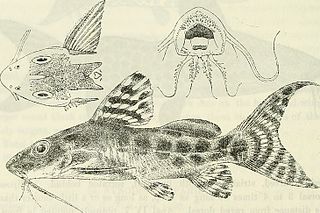
Synodontis ornatipinnis, known as the barfin synodontis, is a species of upside-down catfish that is native to the Congo Basin of the Democratic Republic of the Congo and Zambia. It was first described by British-Belgian zoologist George Albert Boulenger in 1899, from specimens collected in Mbandaka, on the Congo River in what is now the Democratic Republic of the Congo. The species name ornatipinnis means "ornate fins".

Synodontis pardalis is a species of upside-down catfish that is endemic to Cameroon where it occurs in the Dja River drainage. It was first described by British-Belgian zoologist George Albert Boulenger in 1908, from specimens collected in the Dja River in southern Cameroon. The species name pardalis is derived from the Greek word pardalis, which means "leopard", which refers to the spotted pattern on the fish.

Synodontis serratus, known as the shield-head squeaker, is a species of upside-down catfish that is native to the Nile basin of the Democratic Republic of the Congo, Egypt, Ethiopia and Sudan. It was first described by German naturalist and explorer Eduard Rüppell in 1829, from specimens obtained near Cairo, Egypt. The species name serratus comes from the Latin word serra, meaning "saw", which refers to the serrated pectoral spines of the species.

Synodontis smiti, known as the longtail Synodontis, or Smit's Synodontis, is a species of upside-down catfish that is endemic to the Democratic Republic of the Congo where it is found in the middle and upper Congo Basin. It was first described by British-Belgian zoologist George Albert Boulenger in 1902, from specimens obtained in the Ubangi River at Banzyville. The species name smiti is named for Pierre Jacques Smit, who illustrated the plates in Boulenger's works.

Synodontis soloni, known as the scissortail synodontis, is a species of upside-down catfish that is endemic to the Democratic Republic of the Congo where it is found in the Ubangi River and the rapids just below Stanley Pool. It was first described by British-Belgian zoologist George Albert Boulenger in 1899, from the Congo River in what is now the Democratic Republic of the Congo. The species name soloni is a patronym and in memory of Alexandre Solon, who assisted with the collection of fish.
